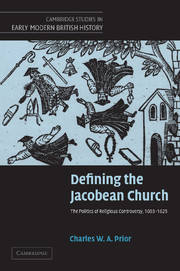Book contents
- Frontmatter
- Contents
- Acknowledgements
- Note on the text
- 1 Introduction: defining the Church
- 2 The language of ecclesiastical polity and Jacobean conformist thought
- 3 Doctrine, law, and conflict over the Canons of 1604
- 4 Apostoli, episcopi, divini?: models of ecclesiastical governance
- 5 Bellum ceremoniale: scripture, custom, and ceremonial practice
- 6 Ceremonies, episcopacy, and the Scottish Kirk
- 7 Conclusion: narratives of civil and ecclesiastical authority
- Bibliography
- Index
- Titles in the series
1 - Introduction: defining the Church
Published online by Cambridge University Press: 09 July 2009
- Frontmatter
- Contents
- Acknowledgements
- Note on the text
- 1 Introduction: defining the Church
- 2 The language of ecclesiastical polity and Jacobean conformist thought
- 3 Doctrine, law, and conflict over the Canons of 1604
- 4 Apostoli, episcopi, divini?: models of ecclesiastical governance
- 5 Bellum ceremoniale: scripture, custom, and ceremonial practice
- 6 Ceremonies, episcopacy, and the Scottish Kirk
- 7 Conclusion: narratives of civil and ecclesiastical authority
- Bibliography
- Index
- Titles in the series
Summary
ECCLESIOLOGY AND HISTORY
In 1699, Gilbert Burnet, then Bishop of Salisbury, published An exposition of the Thirty-nine articles of the Church of England. The work purported to trace the roots of the English confession from the Reformation forward, and in the preface Burnet lamented that a quarrel over ceremonies and worship, ‘and about things that were of their own nature indifferent’, had been raging for ‘above an Hundred Years’. Burnet certainly knew his subject, having been guided through Elizabethan controversies by Andrew Maunsell's bibliography, and by reading widely in the controversial literature published during the reigns of the early Stuarts. This literature gave him a sense that the general tone and quality of the debate had shifted as the Elizabethan period gave way to the controversies over clerical subscription and ceremonial practice in the early years of James VI and I:
Our divines were much diverted in the end of that Reign from better Enquiries, by the Disciplinarian Controversies; and though what Whitgift and Hooker writ on those Heads, was much better than all that came after them; yet they neither satisfied those against whom they writ, nor stopt the Writings of their own side. But as Waters gush in, when the Banks are once broken, so the breach that these had made, proved fruitful. Parties were formed, Secular Interests were grafted upon them, and new Quarrels followed those that first begun the Dispute.
- Type
- Chapter
- Information
- Defining the Jacobean ChurchThe Politics of Religious Controversy, 1603–1625, pp. 1 - 21Publisher: Cambridge University PressPrint publication year: 2005



